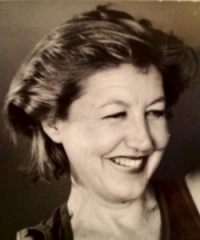

|

|
IN MEMORIAM
Mary Adele Davidson
Professor, Department of Theatre and Dance
UC Davis
1951 — 2012
Della Davidson, a central figure in the Bay Area dance world since the early 1980s, was a vital creative force for the Department of Theatre and Dance and the University of California Davis for over ten years. She was described as one of the West Coast’s most fluent writers for the body, a dance maker of works that ruminate with poignancy and beauty on topics ranging from a woman’s anger to disease, death, and the fragility of human existence. One of her students and colleagues described her as “rich, full bodied, and generous in her sensibilities in the making of art, the education of artists, and the physical expression that underlay her activism toward feeling into those places that language arts alone could never go. Her visual and theatrical mastery came from a fearless play that brought color, light, form and action together in often surprising ways and mediums.”
Della’s choreographic work echoes with references to the United States tradition in modern dance, and yet her dancers performed and still perform with a passionate abandonment of commitment and rage. Over her career she created more than 40 works, and received many honors – including the Isadora Duncan Award for Outstanding Achievement in Choreography, and the 1990 North American Award for Choreography. Born in Texas and raised in Michigan, she arrived in New York in 1972. Ballet trained since elementary school, she discovered that being over six foot on pointe made classical partnering impossible, but at Michigan State she discovered modern dance, and at the University of Utah she apprenticed as a choreographer. After an MA at the University of Arizona, Tucson, she began co-directing the San Francisco Moving Company with Ellen Bromberg. Dance scholar Janice Ross identified the style of Della Davidson’s work as an invitation to interplay between narrative content and physical form, between physicality and theatre. She told Ross that she felt at “home” with a mixture of theatre and education with choreography that emphasizes that “we all have our own artistry.”
Each piece of choreography usually took years to complete, as she worked interactively with the dancers and other collaborators to develop the work. At UC Davis, she was the Artistic Director of the resident professional company of the Mondavi Center for the Performing Arts, Sideshow Physical Theatre, which she also established. A colleague in the Department describes her legacy as a “generosity of spirit and inventiveness of vision that were shared … through working to develop plays for Sideshow, where Della’s input during research phases brought a depth of physical and textual acuity”. A survivor of Hodgkin’s disease, which she conquered at the age of 28, her gift was to make work darkly toned yet human, with beautiful movement that faced tragedy with hope. Driven by an urge to get away from the “roles” she and other women had been brought up to inhabit, she often created dance that evoked the raw energy of forceful women, their strength, physicality and sensuality. Heavily ironic, pieces such as 10 P.M. Dream or fierce/pink/house display gender stereotypes only to expose them as insidious traps, and she was firmly committed to feminism as a challenge to oppression and small-mindedness.
Here at UC Davis she consistently ran a Davis Honors Challenge (DHC) course on “Body Image,” which drew full classes of students each year – often young women and men who were concerned to respect diverse body shapes and movements. Those involved in the Challenge attest to her commitment to opening up new ways to be surprised by unlikely beauty and to find unrecognized sexualities. The University Club Dance Studio, soon to be renamed the Della Davidson Studio, had shelves and shelves of crayons, paints, pastels, multicolored paper, glue, and marker pens – an adult treasure trove of kindergarten colors and textures that her students would use to map out their difficulties and their aspirations all over the dance floor, before taking their re-mappings to the final DHC conference.
A recipient of the Chancellor’s Fellowship at UC Davis, much of her new work was involved in multidisciplinary choreography. Hired just as Theatre and Dance became a merged department, it was she who began to articulate what an interdisciplinary MFA might be. Her students included dancers who have gone on to win national and international awards – Keith Hennessy received the USA Artists Award for Dance in 2012, Jess Curtis won the Alpert Award for Dance in 2011 – and have become the backbone of choreographic teaching at universities and colleges in California. Her presence in the Department was keenly appreciated. Another colleague remembers her as the one person on whom we could count to remind us of the potential our artistic and scholarly work – feeling, the expression of value, community, beauty, diversity and respect. In the midst of an argument at a faculty meeting she would suddenly say “But we are here to make work that gives meaning to life” – which does tend to put things into perspective.
Working again with Ellen Bromberg, the choreographer/dance filmmaker, she co-created The Weight of Memory and, with the CAVES institute in the Geology Department, Collapse (suddenly falling down). Della Davidson was working with Ellen Bromberg on a new piece, “and the snow fell softly on all the living and the dead”, for the spring of 2012 when she passed away.
Her bywords were ‘creativity’ and ‘collaboration’, and one of her greatest gifts was to recognize potential in others and bring out their strengths, whether they were her students, her dancers, her collaborators, her colleagues or her friends.